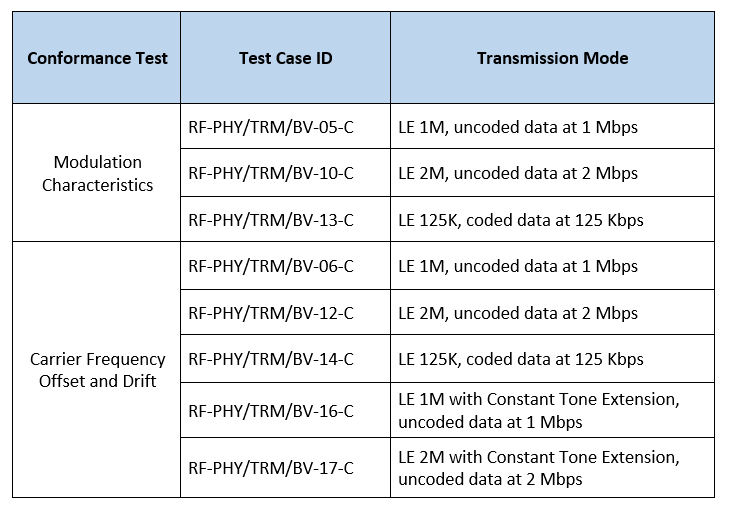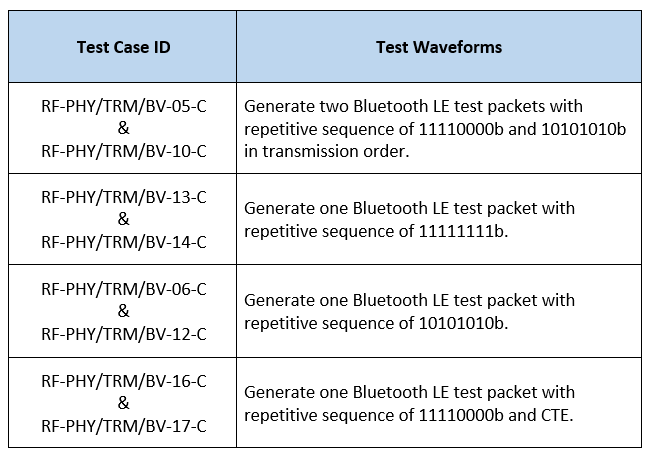Bluetooth LE Modulation Characteristics, Carrier Frequency Offset and Drift Tests
This example shows how to perform Bluetooth® low energy (LE) radio frequency (RF) physical layer (PHY) transmitter tests specific to modulation characteristics, carrier frequency offset, and drift using Bluetooth® Toolbox. The test measurements compute frequency deviation, carrier frequency offset, and drift values. This example also verifies whether these test measurement values are within the limits specified by the Bluetooth RF-PHY Test Specifications [1].
Objectives of LE RF-PHY Tests
The Bluetooth RF-PHY Test Specifications [1] defined by Bluetooth Special Interest Group (SIG) includes RF-PHY tests for both transmitter and receiver. The objectives of these RF-PHY tests are to:
Ensure interoperability between all Bluetooth devices.
Ensure a basic level of system performance for all Bluetooth products.
Each test case has a specified test procedure and an expected outcome, which must be met by the implementation under test (IUT).
RF-PHY Transmitter Tests
The main aim of transmitter test measurements is to ensure that the transmitter characteristics are within the specified limits as specified in the test specifications [1]. This example includes transmitter tests relevant to modulation characteristics, carrier frequency offset, and drift. This table shows various RF-PHY transmitter tests performed in this example.

Transmitter Test Procedure
This block diagram summarizes the test procedure for transmitter tests relevant to modulation characteristics, carrier frequency offset, and drift.

To simulate the transmitter tests, perform these steps.
Generate Bluetooth LE test packet waveform by using the
bluetoothTestWaveformfunction.Add frequency offset, which includes initial frequency offset, and drift to the waveform by using the
comm.PhaseFrequencyOffsetSystem object.Add thermal noise by using the
comm.ThermalNoiseSystem object.Perform filtering on the noisy waveform by using
modulationTestFilterfunction.Perform frequency modulation by using the
bluetoothTestWaveformValidatefunction.Perform test measurement and display the pass verdict by using
helperBLEModulationTestVerdicthelper function.
Generate Bluetooth LE test packets by using the bluetoothTestWaveform function. The test waveform required for different test IDs are:

Configure the Tet Parameters
Specify the test value as "Modulation characteristics" or "Carrier frequency offset and drift".
testValue =  "Modulation characteristics";
"Modulation characteristics";Specify the PHY transmission mode as "LE1M", "LE2M" or "LE125K".
phyMode =  "LE1M";
"LE1M";Specify the payload length in the range [37, 255] bytes.
payloadLength =  240;
240;Specify the length of the frequency pulse shape in the range [1, 4].
pulseLength =  2;
2;Specify the modulation index of GFSK in the range [0.45, 0.55].
modulationIndex =  0.5;
0.5; Specify number of samples per symbol, minimum of 32 samples per symbol as per the test specifications
sps = 32;
Specify the initial frequency offset in the range [-100e3, 100e3].
initialFrequencyOffset =23000; % In Hz
Specify the carrier drift in the range [-50e3, 50e3].
carrierDrift =0; % In Hz
Configure the RF-PHY test configuration by using the bluetoothRFPHYTestConfig object.
configObject = bluetoothRFPHYTestConfig(Test=testValue, ... Mode=phyMode, ... PulseLength=pulseLength, ... ModulationIndex=modulationIndex, ... SamplesPerSymbol=sps, ... PayloadLength=payloadLength, ... InitialFrequencyOffset=initialFrequencyOffset, ... CarrierDrift=carrierDrift);
The constant tone extension (CTE) information field position is same for LE test packet and data packet. For CTE-based RF-PHY tests, specify the packet type as "ConnectionCTE". The default packet type is "Disabled".
configObject.PacketType =  "Disabled";
"Disabled"; Specify CTE length in 8 microseconds units, must be in the range [13, 20] bytes.
if (configObject.PacketType=="ConnectionCTE") configObject.CTELength =13; end
Specify the Bluetooth LE test waveform configuration object by using the bluetoothRFPHYTestConfig object.
testWaveformConfig = bluetoothTestWaveformConfig(Mode=phyMode, ... PayloadLength=configObject.PayloadLength, ... PacketType=configObject.PacketType, ... SamplesPerSymbol=sps, ... CTELength=configObject.CTELength, ... CTEType=configObject.CTEType, ... ModulationIndex=configObject.ModulationIndex, ... PulseLength=configObject.PulseLength);
Based on the PHY transmission mode, compute the sampling rate.
sampleRate = 1e6*(1+1*(phyMode=="LE2M"))*sps;Compute the total number of bits in the Bluetooth test packet by using the bluetoothPacketDuration function.
if (configObject.PacketType=="ConnectionCTE") [~,testWfmSymLen] = bluetoothPacketDuration(phyMode,configObject.PacketType, ... configObject.PayloadLength,configObject.CTELength); else [~,testWfmSymLen] = bluetoothPacketDuration(phyMode,configObject.PacketType, ... configObject.PayloadLength); end
Specify the frequency drift and frequency offset.
testWfmLen = testWfmSymLen*sps; driftRate = configObject.CarrierDrift/testWfmLen; freqDrift = driftRate*(0:1:(testWfmLen-1))'; freqOffset = configObject.InitialFrequencyOffset + freqDrift;
Create a phase frequency offset System object by using comm.PhaseFrequencyOffset System object.
pfo = comm.PhaseFrequencyOffset(FrequencyOffset=freqOffset, ...
SampleRate=sampleRate);Specify the noise figure in dB.
NF = 12;
Create and configure comm.ThermalNoise System object™ to add thermal noise.
thermalNoise = comm.ThermalNoise(NoiseMethod="Noise figure", ... SampleRate=sampleRate, ... NoiseFigure=NF);
Specify the test sequence Id by using the getTestSequenceIds function.
testSequenceIds = getTestSequenceIds(configObject);
Specify the FM demodulation filter using the modulationTestFilter function.
filterDesign = modulationTestFilter(phyMode,sampleRate);
Compute the number of test sequences.
numTestSequences = length(testSequenceIds);
Preallocate memory to filtered waveform.
filteredTestWfm = zeros(testWfmLen,numTestSequences);
Simulate Transmitter Tests
Simulate each Bluetooth LE test waveform for each test sequence.
for countTestSequences = 1:numTestSequences % Generate a Bluetooth LE test waveform with respect to specific % payload type testWaveformConfig.PayloadType = testSequenceIds(countTestSequences); testWfm = bluetoothTestWaveform(testWaveformConfig); % Pass the waveform through phase frequency offset wfmFreqOffset = pfo(testWfm); % Pass waveform through thermal noise wfmChannel = thermalNoise(wfmFreqOffset); % Perform filtering of the noisy waveform filteredTestWfm(:,countTestSequences) = conv(wfmChannel,filterDesign.Numerator.',"same"); end
Validate the filtered waveform by using the bluetoothTestWaveformValidate function. Based on the test, the bluetoothTestWaveformValidate function computes either frequency deviation, or frequency drift and initial frequency offset.
if ((testValue == "Carrier frequency offset and drift") && (configObject.PacketType=="Disabled")) [testWfm,fOut1,fOut2] = bluetoothTestWaveformValidate(filteredTestWfm,configObject); fOut3 = []; else [testWfm,fOut1,fOut2,fOut3] = bluetoothTestWaveformValidate(filteredTestWfm,configObject); end
The helperBLEModulationTestVerdict helper function verifies whether the measurements are within the specified limits, and displays the verdict on the command window.
helperBLEModulationTestVerdict(configObject,testSequenceIds,testWfm,fOut1,fOut2,fOut3)

Test sequence: 11110000
Measured average frequency deviation = 250.0201 kHz
Expected average frequency deviation = 225 kHz to 275 kHz
Result: Pass
Test sequence: 10101010
Expected 99.9% of all maximum frequency deviation > 185000 kHz
Result: Pass
Ratio of frequency deviations between two test sequences = 0.83511
Expected Ratio > 0.8
Result: Pass
This example demonstrated the Bluetooth LE transmitter test measurements specific to modulation characteristics, carrier frequency offset and, drift. The simulation results verify that these computed test measurement values are within the limits specified by Bluetooth RF-PHY Test Specifications [1].
Appendix
The example uses these helpers:
helperBLEModulationTestVerdict— Validate test measurement values and displays the result
Selected Bibliography
Bluetooth® Technology Website. "Bluetooth Technology Website | The Official Website of Bluetooth Technology." Accessed September 24, 2024. https://www.bluetooth.com/.
Bluetooth Special Interest Group (SIG), Inc. “Core Specification – Bluetooth® Technology Website.” Accessed September 24, 2024. https://www.bluetooth.com/specifications/specs/core-specification-5-3/.
Local Functions
function Hd = modulationTestFilter(phyMode,Fsamp) % Design FM demodulation filter multFactor = 1; if (phyMode=="LE2M") multFactor = 2; end Fpass = 550000*multFactor; % Passband Frequency Fstop = 2000000*multFactor; % Stopband Frequency Dpass = 0.028774368332; % Passband Ripple Dstop = 0.0063095734448; % Stopband Attenuation dens = 20; % Density Factor % Calculate the order from the parameters using FIRPMORD. [N, Fo, Ao, W] = firpmord([Fpass, Fstop]/(Fsamp/2), [1 0], [Dpass, Dstop]); % Calculate the coefficients using the FIRPM function. b = firpm(N, Fo, Ao, W, {dens}); Hd = dfilt.dffir(b); end function testSequenceIds = getTestSequenceIds(configObject) switch configObject.TestID case {"RF-PHY/TRM/BV-06-C","RF-PHY/TRM/BV-12-C"} % Carrier frequency offset and drift test without CTE, % uncoded PHY testSequenceIds = 2; case {"RF-PHY/TRM/BV-09-C","RF-PHY/TRM/BV-11-C"} % Modulation Test uncoded PHY testSequenceIds = [1,2]; case {"RF-PHY/TRM/BV-13-C","RF-PHY/TRM/BV-14-C"} % Carrier frequency offset and drift test without CTE % for coded PHY "LE125K" and Modulation Characteristics % for Coded PHY "LE125K" testSequenceIds = 4; case {"RF-PHY/TRM/BV-16-C","RF-PHY/TRM/BV-17-C"} % Carrier frequency Offset and Drift Test with CTE, % Coded PHY testSequenceIds = 1; end end